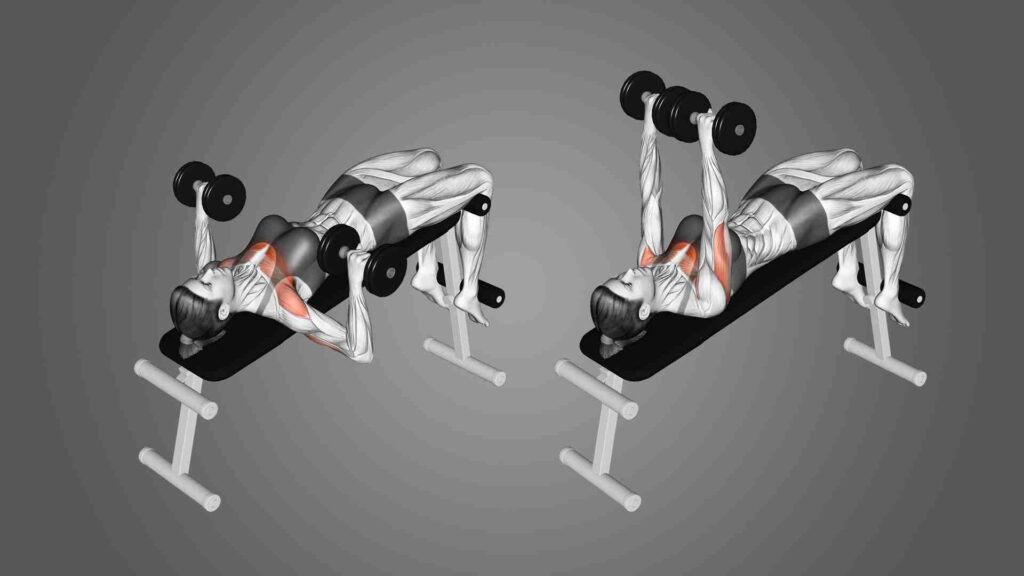Welcome to our comprehensive guide on one of the most effective exercises for building upper body strength – the Dumbbell Bench Press. This exercise is a staple in many workout routines, and for good reason. It targets the pectoral muscles, also known as the chest, but it doesn’t stop there. The Dumbbell Bench Press also works the shoulders and triceps, making it an excellent exercise for overall upper body strength.
But why use dumbbells instead of the traditional barbell for bench pressing? Dumbbells offer a greater range of motion and can help correct muscle imbalances, as both arms can move independently. They’re also a safer option if you’re working out alone without a spotter.
Whether you’re a beginner just starting your fitness journey or an experienced lifter looking to switch up your routine, the Dumbbell Bench Press is a versatile exercise that can help you reach your fitness goals. In this article, we’ll guide you through everything you need to know about the Dumbbell Bench Press, from the equipment needed to proper form and technique.
Introduction to Dumbbell Bench Press

The Dumbbell Bench Press is a popular weightlifting exercise that targets several key muscle groups in your upper body. This exercise is often performed to build stronger and larger chest muscles, but it also significantly engages your shoulders and triceps.
The Dumbbell Bench Press is similar to the traditional Barbell Bench Press, but it uses dumbbells instead of a barbell. The use of dumbbells allows for a greater range of motion compared to the barbell bench press and can help improve your muscle balance and coordination since your arms can’t rely on each other for support.
One of the key benefits of the Dumbbell Bench Press is its ability to work each side of your body independently, which can help correct muscle imbalances and improve coordination.
In addition, the Dumbbell Bench Press is a compound exercise, meaning it works multiple muscle groups at once. This makes it an efficient choice for those looking to get the most out of their workouts. It’s also a functional exercise, as it mimics movements you might do in everyday life, like pushing a heavy object.
Building Wider Shoulders with Rear Delt Exercises
Incorporating the Dumbbell Bench Press into your workout routine can help improve your upper body strength, enhance muscle definition, and contribute to overall fitness.
Equipment Needed
To perform the Dumbbell Bench Press, you will need the following equipment:
- Dumbbells: Choose a pair of dumbbells that are challenging but allow you to maintain proper form throughout the exercise. As you get stronger, you can increase the weight of the dumbbells.
- Weight Bench: A flat weight bench is essential for this exercise. Some benches are adjustable, which allows you to perform the exercise at different angles to target different parts of your chest.
- Mat (Optional): If you don’t have access to a weight bench, you can perform a variation of the exercise on the floor. In this case, a mat can provide comfort and support for your back.
Remember, safety is paramount when performing any exercise. Ensure that the equipment is in good condition before you start, and always use proper form to prevent injuries.
Muscles Worked
The Dumbbell Bench Press is a comprehensive upper body exercise that engages several muscles. The primary muscle group targeted is the pectoralis major, or the chest muscles. This exercise is particularly effective in building and strengthening these muscles.
In addition to the chest, the Dumbbell Bench Press also significantly works the triceps brachii, located in the upper arm. These muscles are engaged when you push the dumbbells upward. Lastly, the anterior deltoids, or the front part of the shoulders, are also involved in this exercise. While these muscles play a more secondary role, they are still crucial for the proper execution of the movement. Therefore, the Dumbbell Bench Press is not only an excellent exercise for building a stronger and larger chest, but also for improving overall upper body strength.
Variations and Modifications
The Dumbbell Bench Press is a versatile exercise with several variations that can target different muscle groups and accommodate various fitness levels. Here are some common variations and modifications:
Variations of Dumbbell Bench Press:
- Incline Dumbbell Bench Press: This variation targets the upper chest muscles more intensely. Perform the exercise on an inclined bench set at an angle of around 30 to 45 degrees. The incline angle places greater emphasis on the clavicular head of the pectoralis major muscle.
- Decline Dumbbell Bench Press: In contrast to the incline variation, the decline dumbbell bench press targets the lower chest muscles. Use a decline bench set at an angle of around 15 to 30 degrees. This variation places more emphasis on the sternal head of the pectoralis major muscle.
- Neutral-Grip Dumbbell Bench Press: Instead of the palms facing away from the body, the neutral-grip variation involves holding the dumbbells with palms facing each other. This variation can reduce strain on the wrists and shoulders for some individuals while still targeting the chest, shoulders, and triceps effectively.
- Single-Arm Dumbbell Bench Press: This variation involves performing the bench press with one arm at a time, which challenges stability and balance while also allowing for unilateral strength development. It’s particularly useful for identifying and addressing muscle imbalances between the left and right sides of the body.
Modifications for Different Fitness Levels:
For Beginners: Beginners should start with light weights to focus on mastering proper form and technique. Begin with a weight that allows you to perform 8-12 reps with good form for 2-3 sets. Focus on gradually increasing the weight as strength improves, ensuring that the form remains consistent.
For Intermediate: Intermediate lifters can increase the challenge by incorporating variations such as incline or decline dumbbell bench press. Increase the weight gradually as strength improves, aiming for 6-10 reps per set for 3-4 sets. Focus on maintaining control throughout the movement and increasing time under tension for muscle growth.
For Advanced: Advanced lifters can further enhance the intensity by incorporating techniques such as drop sets, supersets, or pyramid sets. Experiment with heavier weights for lower reps (4-6 reps) to build strength, or lighter weights for higher reps (12-15 reps) to focus on muscle endurance and hypertrophy. Incorporating variations like single-arm dumbbell bench press can also add complexity and challenge to the workout routine.
Strengthening Upper Back with Dumbbells
Regardless of fitness level, it’s crucial to listen to your body, gradually progress the intensity of the workout, and prioritize proper form and technique to minimize the risk of injury and maximize results.
Benefits of Dumbbell Bench Press
The Dumbbell Bench Press offers several benefits that make it a valuable addition to any workout routine:
- Muscle Symmetry: Dumbbell bench press promotes balanced muscle development as each arm works independently, correcting strength imbalances between the left and right sides of the body.
- Increased Stabilization: Unlike barbell bench press, dumbbell bench press requires greater stabilization from the stabilizer muscles, enhancing overall core strength and stability.
- Range of Motion: Dumbbells allow for a greater range of motion compared to a barbell, enabling deeper muscle contractions and better muscle engagement, leading to improved muscle growth and flexibility.
- Unilateral Strength Development: By working each arm independently, dumbbell bench press helps identify and address weaknesses or muscle imbalances, fostering more symmetrical strength gains.
- Joint Health: The freedom of movement offered by dumbbells reduces strain on the wrists and shoulders, promoting joint health and reducing the risk of overuse injuries associated with fixed barbell movements.
- Functional Strength: Dumbbell bench press mimics real-world movements more closely than barbell bench press, translating to improved functional strength that can benefit daily activities and sports performance.
- Versatility: Dumbbells are versatile and can be used for various exercises targeting different muscle groups, offering flexibility in workout routines and allowing for continuous progression and adaptation.
Romanian Deadlift and Lower Back
Remember, as with any exercise, the benefits of the Dumbbell Bench Press can only be reaped when performed with proper form and technique.
FAQs
Q 1. How can I incorporate the Dumbbell Bench Press into my workout routine?
Ans. The Dumbbell Bench Press can be incorporated into your upper body or chest-focused workout days. It’s typically performed in sets of 8-12 reps, but this can vary based on your fitness level and goals.
Q 2. How often should I perform the Dumbbell Bench Press?
Ans. This depends on your fitness level and goals. If you’re a beginner, you might start by doing this exercise 1-2 times per week. As you become more advanced, you could do it 2-3 times per week.
Q 3. What should I do if I don’t have access to a bench?
Ans. If you don’t have access to a bench, you can perform a variation of the exercise on the floor called the Dumbbell Floor Press. This limits the range of motion, which can make the exercise more manageable for beginners or those with shoulder issues.
Q 4. Can I still do the Dumbbell Bench Press if I have a shoulder injury?
Ans. If you have a shoulder injury, it’s important to consult with a healthcare professional before attempting the Dumbbell Bench Press or any other exercise. They can provide guidance based on your specific situation.
Q 5. How can I progress with the Dumbbell Bench Press?
Ans. You can progress with the Dumbbell Bench Press by gradually increasing the weight of the dumbbells as your strength improves. You can also try variations of the exercise to challenge your muscles in different ways.
Q 6. Is the Dumbbell Bench Press safe for beginners?
Ans. Yes, the Dumbbell Bench Press is safe for beginners as long as it’s performed with proper form and a suitable weight. It’s always a good idea to start with lighter weights and gradually increase as your strength and technique improve.
Q 7. What other exercises complement the Dumbbell Bench Press?
Ans. Other exercises that complement the Dumbbell Bench Press include the Dumbbell Fly, Push-ups, and Cable Cross-overs for the chest. For the triceps, you could do Tricep Dips or Skull Crushers. For the shoulders, Overhead Press or Lateral Raises would be good options.
Conclusion
In conclusion, the Dumbbell Bench Press is a versatile and effective exercise that targets multiple muscle groups, making it a valuable addition to any workout routine. Its ability to correct muscle imbalances, offer a full range of motion, and adapt to various fitness levels sets it apart from other exercises.
Whether you’re a beginner or an experienced lifter, incorporating the Dumbbell Bench Press into your workout regimen can lead to significant improvements in upper body strength and muscle definition. Remember, the key to reaping the benefits of this exercise lies in proper form and technique.

Good day, and welcome to Fitthour. My name is Shubham Vijay, and I am a certified personal trainer and nutrition coach with 6 years of experience in the fitness industry. At Fitthour, we specialize in types of training, such as strength training, cardio, or HIIT, and our mission is to help clients achieve their fitness goals and improve their overall health.

